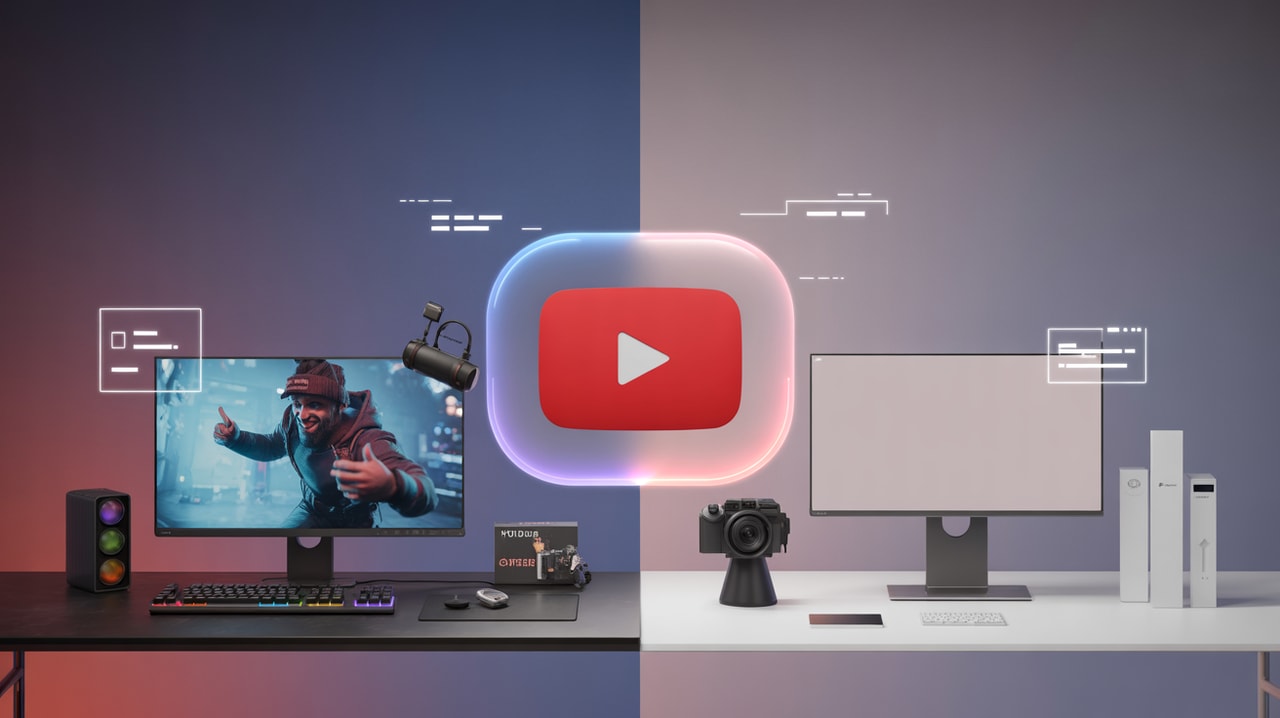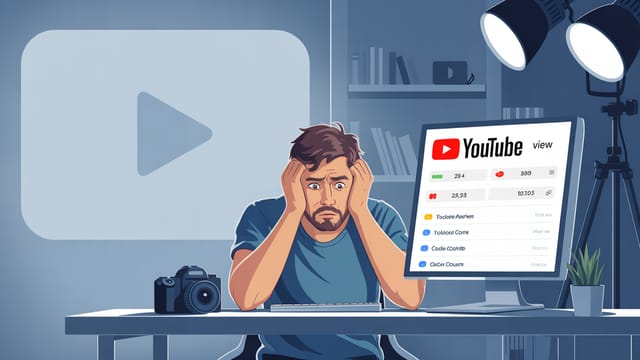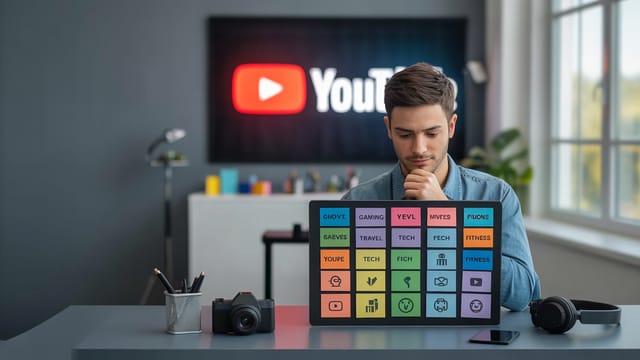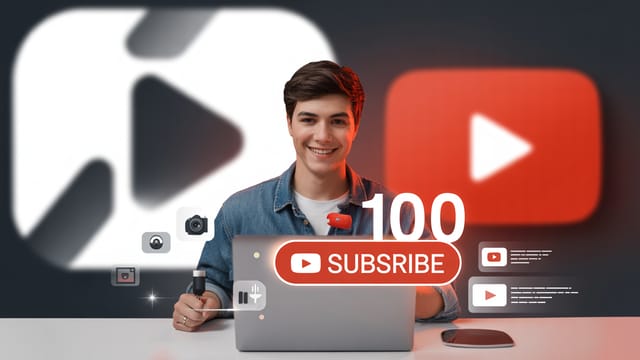
Ready to get your next 10,000 subscribers?
Join thousands of creators who use Subscribr to create faster, better YouTube videos.
Combining YouTube Niches: Genius Strategy or Growth Killer?
Thinking about mashing up your passions into one YouTube channel? You're not alone. Many creators grapple with the idea of combining interests, especially when they feel constrained by a single niche or are overwhelmed by the pressure to pick just one thing. The fear of "niching down too early" can be real, leading creators to wonder if a multi-niche channel is a clever way to explore different topics and audiences, or a surefire path to confusing viewers and stalling growth.
This isn't a simple yes or no question. While the conventional wisdom often shouts "Niche down!", there's a more nuanced reality. Smart niche combination can be a genius strategy, but doing it without a clear plan can absolutely kill your growth before it even starts.
Let's dive into the strategic implications of combining niches, how to figure out if it's right for you, and how to do it effectively if you choose this path.
Is It "Bad" to Have Multiple Topics on YouTube?
The primary concern with having multiple, unrelated topics on a single channel is audience confusion. Imagine subscribing to a channel for its incredible cooking tutorials, only to have your feed suddenly filled with videos about advanced quantum physics. You'd likely unsubscribe, right?
YouTube's algorithm works by understanding what your channel is about and showing it to viewers who are likely to be interested in that specific type of content. If your channel lacks a clear focus, the algorithm struggles to identify your target audience. This can lead to your videos being shown to the wrong people, resulting in low engagement (low watch time, few likes/comments), which signals to YouTube that your content isn't resonating, thus hindering your reach.
Furthermore, a lack of clear niche makes it hard for viewers to understand why they should subscribe. People subscribe because they want to see more of something they like. If your content is a jumble of unrelated topics, they won't know what to expect next and are less likely to hit that subscribe button. As the Think Media Podcast has pointed out, trying to serve two distinct interests on one channel can make it harder for the algorithm to understand and promote your content effectively.
However, this doesn't mean any combination is bad. The key is how you combine them.
The Contrarian View: Why "Niching Down Too Early" Can Sometimes Hurt
While focus is generally good, especially for new creators building an initial audience, the idea of "niching down too early" highlights a different problem: committing to a niche before you truly understand your audience, your own passion for creating within that niche, or what content formats actually work for you.
If you pick a niche that you're not genuinely passionate about, or one where you struggle to consistently produce content, you'll quickly burn out. Similarly, if you Niche down based on what you think is popular without validating audience interest in your specific take on the topic, you might build a channel that nobody wants to watch.
Sometimes, exploring related topics early on can help you discover what resonates most with viewers and what you enjoy creating most. This exploration phase isn't about throwing random topics at the wall, but rather testing different angles or sub-topics within a general area to find your specific lane.
The challenge isn't just having multiple interests; it's about how you present them cohesively and build a predictable content experience for your audience.
How to Combine Niches Successfully
Combining niches effectively isn't about listing your hobbies; it's about finding the intersection of your interests and packaging them into a unique, compelling concept that attracts a specific audience. Here's how to approach it strategically:
1. Find the Overlap and Define Your Combined Niche
Instead of operating two separate channels on one profile, create a brand new niche by combining elements of your interests. Think about the Venn diagram of your passions. Where do they intersect? This intersection is potentially your unique combined niche.
Examples highlighted by YouTube strategists include:
- Combining "What If" scenarios with "Point of View" content.
- Merging "Bedtime Stories" with "Historical Stories" to create "Bedtime History."
- Exploring "Dark Psychology" through the lens of "Historical Figures."
- Combining "Art" and "College Life" into a niche specifically for "College Artists."
The goal is to define this combined niche so clearly that someone instantly understands what your channel is about and who it's for. It needs to feel like a natural, interesting fusion, not a forced combination.
2. Identify and Target Your Specific Audience
A combined niche doesn't mean you target everyone interested in topic A and everyone interested in topic B. You're targeting the specific group of people who are interested in the combination of A and B.
For example, a "College Artists" channel isn't for all college students or all artists; it's for college students who are also artists, or perhaps people interested in the challenges and experiences of pursuing art while in college.
Understanding this specific audience is crucial. What are their unique pain points, interests, and content consumption habits related to this combined topic? Tools like Subscribr's Audience Persona Generation can help you build detailed profiles of your ideal viewer, making it easier to create content that truly resonates.
3. Develop a Clear and Compelling Unique Value Proposition (UVP)
Your UVP is what makes your channel different and why someone should watch your content over similar channels (even those in single niches). It's the core benefit you provide to your specific audience.
For a combined niche, your UVP should clearly articulate the unique perspective or value you offer through the combination. For instance, the UVP for a "Dark Psychology History" channel might be: "We explore the lesser-known manipulative tactics used by historical figures to help you understand power dynamics." This is specific, intriguing, and clearly defines the channel's focus.
Your UVP needs to be compelling and immediately clear wherever your channel is found – on your channel banner, in your video intros, and in your video descriptions. Subscribr's tools can assist in refining your channel's positioning and ensuring your value proposition is consistently communicated.
4. Maintain Consistency and Structure
Even within a combined niche, consistency is key. This means:
- Consistent Theme: Every video should tie back to the core combined niche. Avoid random videos that don't fit.
- Consistent Quality: Maintain a similar level of production value, editing style, and on-screen presence across all your videos.
- Consistent Upload Schedule: While not strictly about niche, a regular schedule helps train your audience and the algorithm.
Structure your content logically. Playlists are essential for multi-topic channels, even combined ones, allowing viewers to easily find the content they're most interested in within your niche fusion.
5. Leverage the Strengths of Both Niches
A successful combined niche takes the most engaging or evergreen elements from each source niche. For example, combining a popular format (like a "Top 10" list) with a popular subject can create a unique angle within that subject area, as suggested by Make Money Matt.
Analyze successful channels in both of the niches you plan to combine. What content formats, topics, and presentation styles perform well? How can you adapt these proven strategies for your unique fusion? Subscribr's Channel and Video Intel features can help you analyze top performers and identify successful patterns.
Will Combining Niches Confuse My Audience?
Yes, if not done correctly. If you simply upload videos about unrelated topics without a unifying theme or clear explanation, your audience will be confused.
However, if you successfully create a new, defined niche from the combination, clarify your UVP, and consistently deliver content that fits that specific fusion, you won't confuse the audience interested in that unique combination. You will attract a specific group of viewers who are excited by the blend of topics you offer.
The confusion arises when the creator hasn't clearly defined the combined niche for themselves and their audience. It's the difference between a channel that's "about cooking and gaming" and one that's "about the science of cooking in video games" (a hypothetical combined niche). The latter has a clear focus, while the former is just two separate topics.
Monetization Opportunities in Combined Niches
A well-executed combined niche can create unique monetization opportunities. By attracting an audience interested in the intersection of two areas, you position yourself uniquely for sponsorships, affiliate marketing, and even your own products.
For example, a channel combining fitness and cooking could attract sponsorships from fitness equipment brands and healthy food companies. If they create their own products, they could offer fitness guides and recipe books, appealing to both aspects of their audience's interests within the combined niche. This smart niche combination creates a unique channel identity that can attract a broader or more engaged audience, leading to diverse monetization avenues.
Subscribr: Your Partner in Niche Strategy
Navigating the complexities of finding and developing your YouTube niche, whether single or combined, requires strategic planning and data-driven insights. Subscribr is designed to support creators at every step:
- Niche Definition & Validation: Use Subscribr's Research Assistant and AI Chat to explore potential niche combinations, research audience interest, and refine your concept.
- Unique Value Proposition: Leverage Subscribr's tools to analyze successful channels and articulate what makes your combined niche offering unique and compelling.
- Content Strategy: Plan your content pipeline with the Script Building Pipeline, ensuring every video aligns with your defined combined niche and UVP.
- Audience Intelligence: Build detailed audience personas to understand the specific needs and interests of viewers in your unique niche intersection.
- Performance Analysis: Track how your combined niche content performs using Channel and Video Intel, identifying what resonates most with your specific audience.
Combining YouTube niches isn't a shortcut; it's a strategic choice that requires careful planning, clear communication, and consistent execution. By defining your unique combined niche, understanding your specific audience, and articulating a compelling value proposition, you can turn the potential confusion of multiple topics into a powerful growth engine that sets you apart on the platform. Don't just combine topics – create a brand new category of one.





